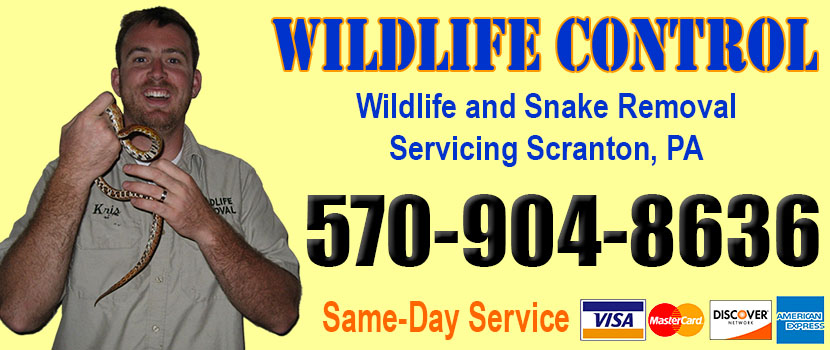
Welcome to scrantonsnakes.com! I am David, a snake enthusiast living in Scranton, PA. Many people don't know that Scranton is in fact full of snakes! You just need to know where to find them - they can often be shy and elusive. Some Pennsylvania snake species are more common outside of the city limits, in different parts of Lackawanna County PA, but many types of snakes are indeed common in the more urban parts of Scranton. This guide is meant to help educate you about the beautiful snakes of Scranton, and to help you identify the most common snakes of Scranton, as well as the venomous snakes of Scranton that you should learn to recognize and avoid. If you want more detail, click here for my complete list of ALL snake species in Scranton. Remember the following:
- Most snakes of Scranton are harmless and don't want to encounter you
- Venomous snakes exist but are uncommon in Scranton, Pennsylvania
- Snakes eat rats and mice and are a valuable part of the Pennsylvania ecosystem
- Never kill a snake - if you leave a snake alone, it will leave you alone.
Common Snake Species in Scranton
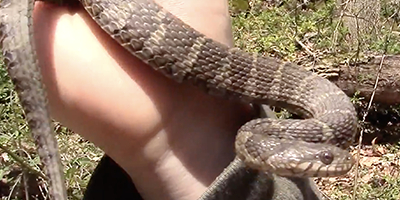 Northern Water Snake(Nerodia sipedon sipedon):
Northern Water Snake(Nerodia sipedon sipedon): Appearance: The northern water snake is a heavy-build species, medium in size, with the adult body length ranging from 24 to 55 inches. Body-color varies from buff, brown, and tan to gray, with the juveniles being more conspicuous.
Habitat: As the name suggests, this species lives near water bodies, including lakes, rivers, streams, and ponds. They feed on fish, tadpoles, frogs, and turtles.
Behavior: The northern water snake's behavior depends on weather conditions. During winter, they live together coiled or basking in the outdoors. However, they are solitary during the warm season and can be spotted along walkways, hanging branches, or stems.
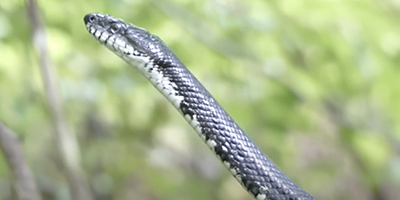 Eastern Rat Snake (Pantherophis alleghaniensis):
Eastern Rat Snake (Pantherophis alleghaniensis): Appearance: The eastern rat snake's body measures 1 to 2 meters long. Its head is broader than the body and neck. It has shiny-black scales along the back. The belly is light, while the throat and chin are white.
Habitat: This reptile lives in open-wooded areas, farmlands, and meadows. When it comes to looking for food, they hunt for bird eggs, rodents around buildings, and amphibians.
Behavior: The eastern rat snake produces a choking odor to repel enemies once it senses danger. During winter, this snake hibernates and resurfaces only in life-demanding situations like feeding and drinking water. However, they are active during the warm months of summer.
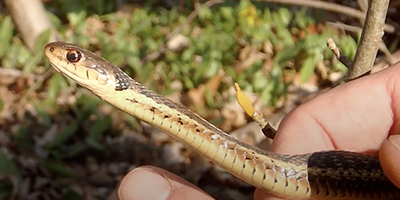 Eastern Garter Snake (Thamnophis sirtalis):
Appearance: The eastern garter's body is slightly stout, medium in size with keeled dorsal scales. An adult garter snake is 20 to 28 inches long. It has a dull-brown or green back with stripes, while the belly is cream or white with red or black spots in two rows. The head coloration varies from grey, brown, black to red.
Eastern Garter Snake (Thamnophis sirtalis):
Appearance: The eastern garter's body is slightly stout, medium in size with keeled dorsal scales. An adult garter snake is 20 to 28 inches long. It has a dull-brown or green back with stripes, while the belly is cream or white with red or black spots in two rows. The head coloration varies from grey, brown, black to red. Habitat: They are abundant near water bodies, forests, backyards, and swampy regions—almost everywhere, including human habitats. They feed on earthworms, fish, and other small water animals.
Behavior: Eastern garter snakes respond to predatory attacks by raising their body temperatures. This prepares them to either fight back or escape. They are active during the day and dormant during the night.
Venomous Snake Species in Scranton
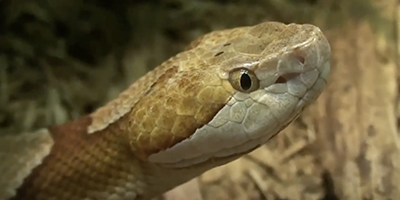 Northern Copperhead (Agkistrodon contortrix moccasin):
Northern Copperhead (Agkistrodon contortrix moccasin): Appearance: A fully grown copperhead is 24-36 inches long, with a flat, large, and triangular head. The body is gray-brown to light tan with narrow brown bands that widen on the edges. Unlike the fully-grown copperhead, the juveniles are yellow with a bright green tail.
Habitat: Copperheads live in the fields, rock slides, edges, and clearings. They are ambush hunters that inject venom into their prey before swallowing them whole. These dangerous reptiles feed on rodents, small snakes, and insects.
Behavior: When it comes to behavior, copperheads are social creatures. Sometimes, they inhabit the same dens with other snakes like black rat snakes. When threatened, this reptile bites to get off the assailant's hook.
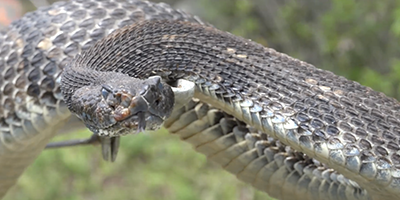 Timber Rattlesnake (Crotalus horridus):
Timber Rattlesnake (Crotalus horridus): Appearance: An adult timber rattlesnake is 3.5-5 feet long with a stout dark-brown body to bright yellow. Also, it has A V-shape band running along the body colors. In addition to that, they have a triangular head and a black tail with a rattle.
Habitat: They live in crevices where they hibernate during winter. Also, rock outcroppings and ledges of forests are essential for food and basking. Their sources of food include voles, mice, chipmunks, lizards, and small birds.
Behavior: Male timber rattlesnakes move far away from their resident sites to better areas during summer, while females stay around their den and travel only a few meters and back. They hibernate with black rat and copperhead snakes. This is yet another lethal snake whose venom can cause a myriad of health challenges
If you're unsure, you can email me a photo of the snake at info@scrantonsnakes.com and I will email you back with the snake's species. If you found a snake skin, read my Found a Skin? page, and you can email me a photo of the skin, and I'll identify the snake for you. If you need professional Scranton snake removal help, click my Get Help page, or see the below website sponsor I found, who provides that service.
What plants will keep snakes away?
People are always on the hunt for things to keep snakes away, as if snakes were one of the worst animals you could have living around your home. For sure, snakes have a startle factor. No one likes to be walking and to suddenly have something slither by your feet from what seems like nowhere. But beyond that, and ignoring the few venomous snakes out there, a snake in the yard isn’t the worst thing in the world. Snakes are essential to the population control of smaller animals. If you don’t want a yard overrun by rodents, you might want to consider keeping that random snake around when he shows up.
No matter how beneficial they are, however, snakes will always strike fear into people’s hearts. Because of that, people are always on the lookout for the latest and greatest way to get rid of snakes, and that includes planting all sorts of random vegetation to discourages these reptilian intruders. Before you go out and buy every exotic plant in the garden center, you need to know that no plants are effective in keeping snakes away. Snakes are designed to slither across all manners of harsh terrain. If a snake can make it across your gravel driveway, no prickly plant is going to deter it for long. Even if a snake doesn’t like the prickles of a cactus, these animals are so low to the ground they are immune to most plants’ defenses. Do not waste your time; snakes are not bothered by textures, and they are not affected by smell the same way mammals are. You are not going to buy a dozen pots of ground cover and be snake-free.
Keeping snakes away is actually more of an opposite effort in respect to gardening. Less landscaping and shorter grass is better at keeping snakes away than planting new vegetation. Snakes are likely around your home because the area encourages the things snakes like to eat. You might have tall, lush grass and gardens that lure rodents and amphibians. Snakes will be close behind because they like to eat these creatures. So, if you want to know what plants keep snakes away, the answer is none. And even better, less of what you’ve already got. All nuisance animals are after basic survival needs. If you don’t provide food, water, or shelter, they are going to find it somewhere else.
Occasionally, snakes will live closer to your home than you’d like, and this can be remedied with the use of glue traps. Glue traps lure snakes in using scent nodules. Once inside, the adhesive keeps the snake from leaving. The downside is you have to actively check the traps to make sure snakes don’t dehydrate to death. The animals can easily be set free somewhere else with some water and a little soap. Snakes are beneficial to keeping dangerous rodents in check. Don’t kill snakes needlessly.
Remember, the term is not poisonous snakes of Scranton, it's venomous snakes of Scranton. Poison is generally something you eat, and venom is injected into you. That said, dangerous snakes are very rare in Scranton. The few venomous snakes of Lackawanna County are rarely seen. But they are commonly misidentified, so learn about all the snake species of Scranton in order to correctly identify them. These snakes are usually also found in the surrounding towns of Scranton, Clarks Summit, Dunmore, Dickson City, Carbondale, Old Forge, Archbald, Jessup, Taylor, Jermyn, Moscow, Moosic, Olyphant, Throop, Clarks Green, Dalton, Blakely, Mayfield, Vandling, Simpson, Mount Cobb, Glenburn, Chinchilla, and the surrounding areas.
Read our article about:
Humane Snake Removal
scrantonsnakes.com domain and hosting costs made possible by the generous support of this sponsor:
